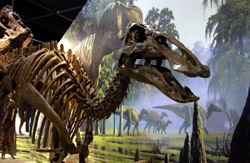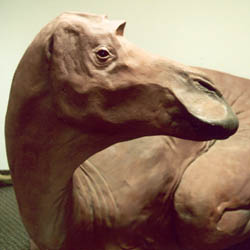Maiasaura
Updated: August 5, 2020

Maiasaura are in the "hadrosaurs" family. All hadrosaurs were medium-sized, bipedal, herbivorous dinosaurs of the Upper Cretaceous Period with long flat snouts and a crested skull. They also had three toes on the hind feet and four toes on the front. An adult Maiasaura was nearly thirty feet long, weighed about three tons, and had a tiny knob between its eyes. The dinosaur walked on its hind legs, with its tail held out straight for balance. When newly hatched, the duck-billed dinosaur was less than fourteen inches long and weighed about one and a half pounds. Adults grew to over thirty feet in length and weighed three tons.
Paleontology circles were stunned when Montana was found to be the home of one of the most important dinosaur discoveries. Named "Egg Mountain," this site has provided more information about dinosaur biology than any other site in the world. The site also revealed the sizes of Maiasaura at different stages of development: it contained the first unhatched dinosaur embryo ever found in the United States, fossilized eggs, embryonic bone, babies, juveniles, and adults of several different dinosaur types. Jack Horner, Curator of Paleontology at the Museum of the Rockies in Bozeman, is credited with the discovery of the dinosaur site and is in charge of the research on the discoveries at the museum where many of them are on display.
The findings at Egg Mountain provided valuable evidence that Maiasaura, who lived during the Upper Cretaceous Period in what is now Montana, nested in extensive colonies and had nests six feet in diameter with as many as twenty eggs. The nest was seven feet wide and two and one half feet deep, and shaped like a bowl. It's believed the young may have remained in the nest for up to two months. This demonstrated for the first time parental care of dinosaur young. This is the reason the name Maiasaura, which means “good mother lizard,” was chosen for this dinosaur. The second part of its scientific name, peeblesorum, honors the Peebles, a Montana ranch family from the Choteau area where the discoveries were made.

The reason Dr. Horner believed that Maiasaura fed their babies, rather than laying eggs and abandoning the nest as modern lizards and turtles do, has a lot to do with the materials found in the nest. Regurgitated bits of vegetable matter, and broken eggshells are two of the clues that support this idea. It is the view of some scientists that Maiasaura brought food back to the nest so that their young could eat. The bones of young Maiasaura have been studied and Dr. Horner believes that the babies could not walk when hatched, and were therefore dependent on their parents, just like many baby birds are now. It is also suggested that since the adults were too large to sit on the nest and incubate the eggs vegetation placed in the nest fermented and warmed the eggs.
There is a lot of scientific debate about these animals being warm-blooded, or endothermic, instead of cold-blooded, or exothermic, like today’s reptiles. Since two small dinosaurs have been found on top of nests, some people think that they sat on their nest and used their body heat to hatch eggs as birds do. The best argument for warm-bloodedness is that the Maiasaura grew very rapidly. They know this because they compared the size of the embryonic Maiasaura with the juveniles and others. They hatched out at thirteen inches long and grew to ten feet at one year of age. Cold-blooded animals do not grow that fast because they have much slower metabolisms. Modern reptiles also have something like growth rings on their bones, but the bones of Maiasaura resemble the bones of warm-blooded animals.
Maiasaura had very unusual teeth, which were great for chewing plants. Study of preserved scat shows wood fibers that were chewed into a nearly sawdust-like consistency. This is unusual when you compare the Maiasaura to modern reptiles. Some modern reptiles eat meat, and some others eat vegetables and fruit, but none of them graze or eat wood. Maiasaura’s mouth was full of teeth that met at an angle. This unique plate-like structure is called a "dental magazine." Each Maiasaura had about 150 teeth, and worn teeth were always being replaced. The dental magazine was made up of two jaws, each jaw held about 75 functioning teeth at one time. Their teeth fit tightly together to form a large flat grinding surface. For each functioning tooth, there were four to five growing teeth ready to replace it if needed.

Montana's school children had a direct influence in the selection of the state fossil, the duck-billed dinosaur (Maiasaura peeblesorum), sponsored by Representative Orval Ellison of McLeod and signed into law by Governor Ted Schwinden on February 22, 1985. Leading the promotion for the state fossil was Ben Veach, former president of the Montana State Council of Rocks and Minerals from Livingston. Helen Peterson, sixth-grade teacher from Livingston Middle School, picked up his enthusiasm and passed it along to her students.
Dr. Mick Hager, Director of the Museum of the Rockies and Horner presented a slide show to the students on the duck-billed dinosaur and plans were put in motion to make it the state fossil. The students wrote letters to the Governor and legislators and sent petitions to all the other schools in the state. In just a short time they had 8,574 signatures from 60 schools.
After Representative Ellison introduced his State Fossil Bill, 130 Livingston students came to the Capitol for a hearing in the Old Supreme Court Chamber. They wore dinosaur t-shirts and had prepared dinosaur pictures, banners, songs, poems, speeches, and even baked 2,000 dinosaur cookies to be served in the Capitol rotunda. They were joined in their efforts by representatives of the rock clubs of Montana.
The children pointed out that naming a dinosaur as the state fossil would increase awareness that Montana is one of the best places in the world for the occurrence of important dinosaur discoveries. They said the Choteau site is of tremendous scientific value and has received widespread publicity in the media and in national and international scientific journals. When the chairman of the hearing called for a vote, it was unanimous. Asked if there was any dissent, one committeeman said, "Who would dare say no?"
Because of the dedicated efforts of Ben Veach, Helen Peterson and the children of Livingston, Governor Schwinden signed the state fossil bill in a special ceremony at Livingston Middle School. The Governor said, "It's very rare that bills are signed into law outside the Capitol, but the circumstances in this case certainly warranted that."
For more information about dinosaurs in Montana follow the Montana Dinosaur Trail.
Updated: August 5, 2020

